Text
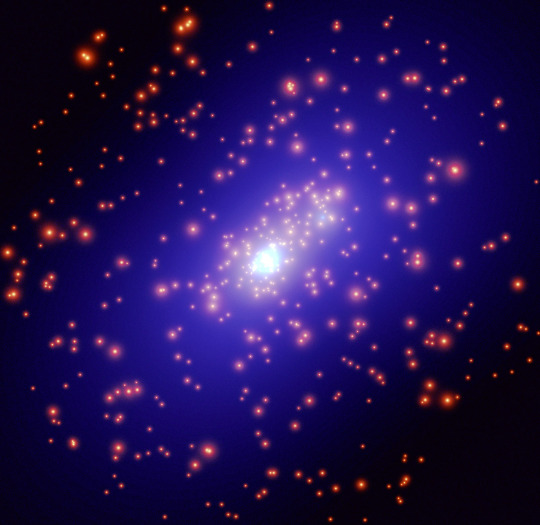
𝑮𝒂𝒍𝒂𝒙𝒚 𝑪𝒍𝒖𝒔𝒕𝒆𝒓 CL0024+1654
This is a mass map of galaxy cluster CL0024+1654 derived from an extensive Hubble Space Telescope campaign.
117 notes
·
View notes
Text
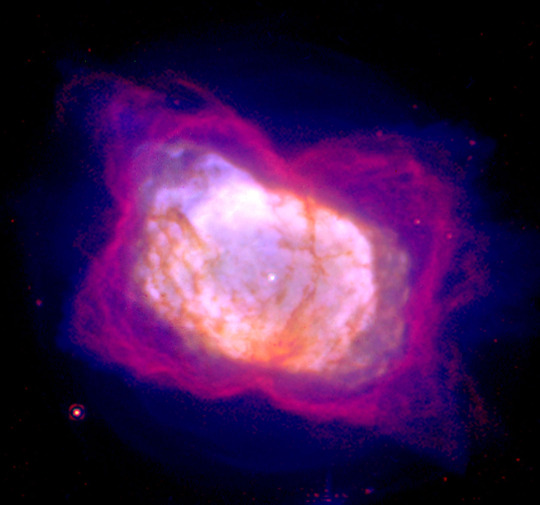
𝑷𝒍𝒂𝒏𝒆𝒕𝒂𝒓𝒚 𝑵𝒆𝒃𝒖𝒍𝒂 𝑵𝑮𝑪 7027
This visible and infrared light picture of NGC 7027 provides a more complete view of how this planetary nebula is being shaped, revealing steps in its evolution.
115 notes
·
View notes
Text

𝑷𝒓𝒐𝒕𝒐𝒔𝒕𝒂𝒓 𝒘𝒊𝒕𝒉𝒊𝒏 𝒅𝒂𝒓𝒌 𝒄𝒍𝒐𝒖𝒅 L1527
The protostar itself is hidden from view within the “neck” of this hourglass shape. An edge-on protoplanetary disk is seen as a dark line across the middle of the neck. Light from the protostar leaks above and below this disk, illuminating cavities within the surrounding gas and dust.
The region’s most prevalent features, the clouds colored blue and orange in this representative-color infrared image, outline cavities created as material shoots away from the protostar and collides with surrounding matter. The colors themselves are due to layers of dust between Webb and the clouds. The blue areas are where the dust is thinnest. The thicker the layer of dust, the less blue light is able to escape, creating pockets of orange.
Webb also reveals filaments of molecular hydrogen that have been shocked as the protostar ejects material away from it. Shocks and turbulence inhibit the formation of new stars, which would otherwise form all throughout the cloud. As a result, the protostar dominates the space, taking much of the material for itself.
Despite the chaos that L1527 causes, it’s only about 100,000 years old - a relatively young body. Given its age and its brightness in far-infrared light as observed by missions like the Infrared Astronomical Satellite, L1527 is considered a class 0 protostar, the earliest stage of star formation. Protostars like these, which are still cocooned in a dark cloud of dust and gas, have a long way to go before they become full-fledged stars. L1527 doesn’t generate its own energy through nuclear fusion of hydrogen yet, an essential characteristic of stars. Its shape, while mostly spherical, is also unstable, taking the form of a small, hot, and puffy clump of gas somewhere between 20 and 40% the mass of our Sun.
As the protostar continues to gather mass, its core gradually compresses and gets closer to stable nuclear fusion. The scene shown in this image reveals L1527 doing just that. The surrounding molecular cloud is made up of dense dust and gas being drawn to the center, where the protostar resides. As the material falls in, it spirals around the center. This creates a dense disk of material, known as an accretion disk, which feeds material to the protostar. As it gains more mass and compresses further, the temperature of its core will rise, eventually reaching the threshold for nuclear fusion to begin.
The disk, seen in the image as a dark band in front of the bright center, is about the size of our solar system. Given the density, it’s not unusual for much of this material to clump together - the beginnings of planets. Ultimately, this view of L1527 provides a window into what our Sun and solar system looked like in their infancy.
295 notes
·
View notes
Text
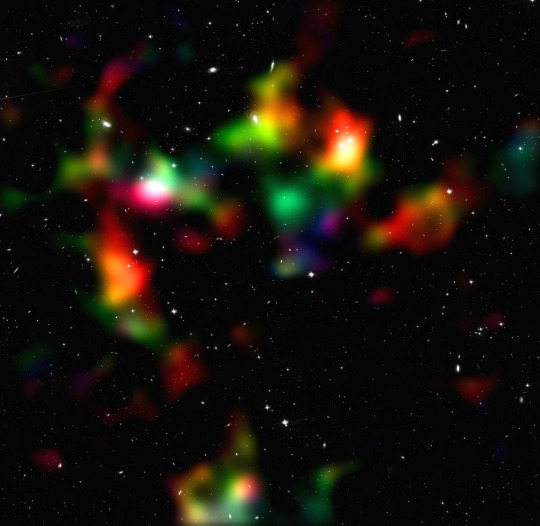
𝑪𝑶𝑺𝑴𝑶𝑺 𝑭𝑰𝑬𝑳𝑫
This image shows a smoothed reconstruction of the total (mostly dark) matter distribution in the COSMOS field, created from data taken by the NASA/ESA Hubble Space Telescope and ground-based telescopes. It was inferred from the weak gravitational lensing distortions that are imprinted onto the shapes of background galaxies. The colour coding indicates the distance of the foreground mass concentrations as gathered from the weak lensing effect. Structures shown in white, cyan, and green are typically closer to us than those indicated in orange and red. To improve the resolution of the map, data from galaxies both with and without redshift information were used.
The new study presents the most comprehensive analysis of data from the COSMOS survey. The researchers have, for the first time ever, used Hubble and the natural "weak lenses" in space to characterise the accelerated expansion of the Universe.
157 notes
·
View notes
Text

𝑮𝒂𝒍𝒂𝒙𝒚 𝑪𝒍𝒖𝒔𝒕𝒆𝒓 𝑴𝑨𝑪𝑺 𝑱0717
In October of 2013 Hubble kicked off the Frontier Fields programme, a three-year series of observations aiming to produce the deepest ever views of the Universe. The project’s targets comprise six massive galaxy clusters, enormous collections of hundreds or even thousands of galaxies. These structures are the largest gravitationally-bound objects in the cosmos.
One of the Frontier Fields targets is shown in this new image: MACS J0717.5+3745, or MACS J0717 for short. MACS J0717 is located about 5.4 billion light-years away from Earth, in the constellation of Auriga (The Charioteer). It is one of the most complex galaxy clusters known; rather than being a single cluster, it is actually the result of four galaxy clusters colliding.
This image is a combination of observations from the NASA/ESA Hubble Space Telescope (showing the galaxies and stars), the NASA Chandra X-ray Observatory (diffuse emission in blue), and the NRAO Jansky Very Large Array (diffuse emission in pink). The Hubble data were collected as part of the Frontier Fields programme mentioned above.
Together, the three datasets produce a unique new view of MACS J0717. The Hubble data reveal galaxies both within the cluster and far behind it, and the Chandra observations show bright pockets of scorching gas — heated to millions of degrees. The data collected by the Jansky Very Large Array trace the radio emission within the cluster, enormous shock waves — similar to sonic booms — that were triggered by the violent merger.
79 notes
·
View notes
Text
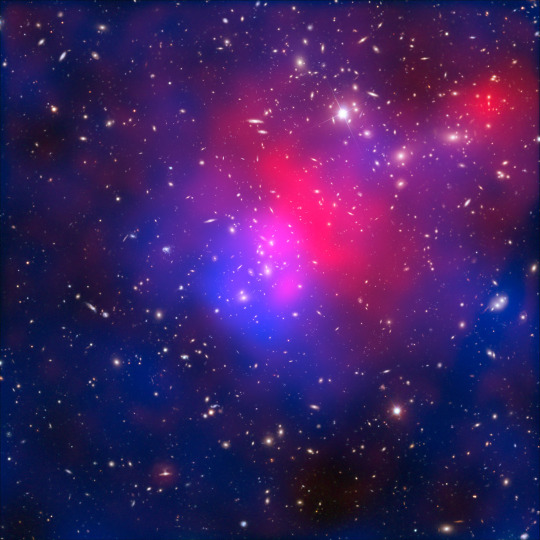
𝑮𝒂𝒍𝒂𝒙𝒚 𝑪𝒍𝒖𝒔𝒕𝒆𝒓 𝑨𝒃𝒆𝒍𝒍 2744
This image combines visible light exposures of galaxy cluster Abell 2744 taken by the NASA/ESA Hubble Space Telescope and the European Southern Observatory’s Very Large Telescope, with X-ray data from NASA’s Chandra X-ray Observatory and a mathematical reconstruction of the location of dark matter.
The galaxies in the cluster, while they are the only part that is visible in the optical part of the spectrum, actually only provide around 5% of the mass in the cluster.
Hot intracluster gas (shown in pink) is visible through its X-ray emissions, observed by NASA’s Chandra satellite.
The blue overlay shows a map of the mass in the cluster. This is reconstructed based on detailed analysis of the way that the cluster bends light from galaxies in the distant background. Evidence of this light bending can be seen in arc-like distortions in parts of this image. Since dark matter makes up the lion’s share of mass in the cluster — around 75% — this blue overlay reveals the location of the otherwise invisible dark matter.
Analysis of this data has allowed scientists to observe some strange phenomena in Abell 2744, including a pocket of dark matter with no gas or galaxies, and a clump of galaxies with no associated gas. Astronomers believe that Abell 2744 formed from the simultaneous pile-up of at least four separate clusters.
86 notes
·
View notes
Text
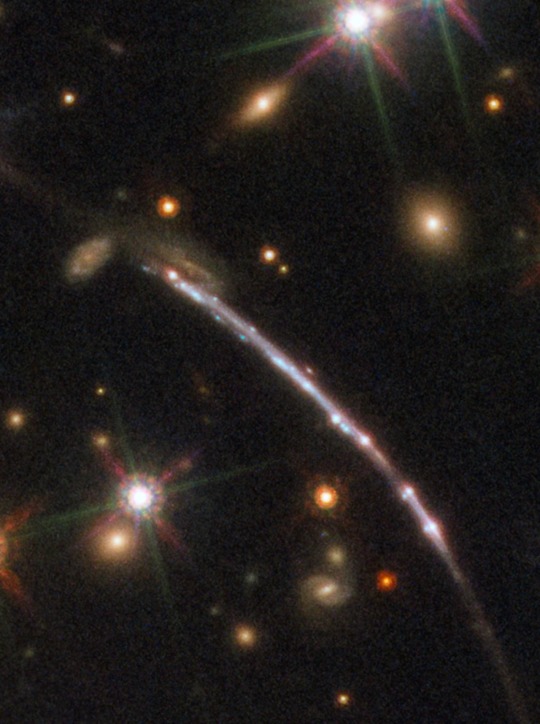
𝑺𝒖𝒏𝒃𝒖𝒓𝒔𝒕 𝑨𝒓𝒄 𝑮𝒂𝒍𝒂𝒙𝒚
This image, taken with the NASA/ESA Hubble Space Telescope, shows one of four arcs formed of the light from the galaxy nicknamed the Sunburst Arc. Created by strong gravitational lensing, this bright arc of light consists of at least four copies of the image of a single galaxy. The lensed galaxy is about 11 billion light-years away.
155 notes
·
View notes
Text

𝑮𝒂𝒍𝒂𝒙𝒚 𝑪𝒍𝒖𝒔𝒕𝒆𝒓 𝑴𝑨𝑪𝑺 𝑱0416
At first glance, this cosmic kaleidoscope of purple, blue and pink offers a strikingly beautiful — and serene — snapshot of the cosmos. However, this multi-coloured haze actually marks the site of two colliding galaxy clusters, forming a single object known as MACS J0416.1-2403 (or MACS J0416 for short).
MACS J0416 is located about 4.3 billion light-years from Earth, in the constellation of Eridanus. This new image of the cluster combines data from three different telescopes: the NASA/ESA Hubble Space Telescope (showing the galaxies and stars), the NASA Chandra X-ray Observatory (diffuse emission in blue), and the NRAO Jansky Very Large Array (diffuse emission in pink). Each telescope shows a different element of the cluster, allowing astronomers to study MACS J0416 in detail.
As with all galaxy clusters, MACS J0416 contains a significant amount of dark matter, which leaves a detectable imprint in visible light by distorting the images of background galaxies. In this image, this dark matter appears to align well with the blue-hued hot gas, suggesting that the two clusters have not yet collided; if the clusters had already smashed into one another, the dark matter and gas would have separated. MACS J0416 also contains other features — such as a compact core of hot gas — that would likely have been disrupted had a collision already occurred.
Together with five other galaxy clusters, MACS J0416 is playing a leading role in the Hubble Frontier Fields programme, for which this data was obtained. Owing to its huge mass, the cluster is in fact bending the light of background objects, acting as a magnifying lens. Astronomers can use this phenomenon to find galaxies that existed only hundreds of million years after the big bang.
104 notes
·
View notes
Text

𝑻𝒉𝒆 𝑬𝒔𝒌𝒊𝒎𝒐 𝑵𝒆𝒃𝒖𝒍𝒂
The breathtakingly beautiful Eskimo Nebula is an intricate structure of shells and streamers of gas around a dying Sun-like star 5000 light-years away. The disc of material is embellished with a ring of comet-shaped objects, their tails streaming away from the central, dying star. The planetary nebula began to form about 10 000 years ago, when the dying star started to expel an intense 'wind' of high-speed material out into space.
146 notes
·
View notes
Text

𝑱𝒂𝒎𝒆𝒔 𝑾𝒆𝒃𝒃 𝑻𝒆𝒍𝒆𝒔𝒄𝒐𝒑𝒆'𝒔 𝑷𝒊𝒍𝒍𝒂𝒓𝒔 𝒐𝒇 𝑪𝒓𝒆𝒂𝒕𝒊𝒐𝒏
297 notes
·
View notes
Text

𝑵𝑮𝑪 1291
This image from NASA Galaxy Evolution Explorer shows the galaxy NGC 1291, located about 33 million light-years away in the constellation Eridanus. NGC 1291 is notable for its unusual inner bar and outer ring structure.
108 notes
·
View notes
Text
𝑻𝒉𝒂𝒏𝒌 𝒚𝒐𝒖 𝒔𝒐 𝒎𝒖𝒄𝒉 𝒇𝒐𝒓 2000 𝒇𝒐𝒍𝒍𝒐𝒘𝒆𝒓𝒔!!
I’m so glad to be able to share the wonders of the universe with all of you!
10 notes
·
View notes
Text

𝑵𝑮𝑪 1448
NGC 1448, a galaxy with an active galactic nucleus, is seen in this image combining data from the Carnegie-Irvine Galaxy Survey in the optical range and NuSTAR in the X-ray range. This galaxy contains an example of a supermassive black hole hidden by gas and dust. X-ray emissions from NGC 1448, as seen by NuSTAR and Chandra, suggests for the first time that, like IC 3639 in PIA21087, there must be a thick layer of gas and dust hiding the active black hole in this galaxy from our line of sight.
78 notes
·
View notes
Text

𝑻𝒉𝒆 𝑪𝒊𝒈𝒂𝒓 𝑮𝒂𝒍𝒂𝒙𝒚
This infrared image from NASA Spitzer Space Telescope shows a galaxy that appears to be sizzling hot, with huge plumes of smoke swirling around it. The galaxy is known as Messier 82 or the Cigar galaxy.
251 notes
·
View notes
Text

𝑴𝒂𝒇𝒇𝒆𝒊 2
Maffei 2 is the poster child for an infrared galaxy that is almost invisible to optical telescopes. But this infrared image from NASA Spitzer Space Telescope penetrates the dust to reveal the galaxy in all its glory.
59 notes
·
View notes
Text

𝑮𝒂𝒍𝒂𝒙𝒚 𝑪𝒆𝒏𝒕𝒂𝒖𝒓𝒖𝒔 𝑨
This image of the active galaxy Centaurus A was taken by NASA's Galaxy Evolution Explorer on June 7, 2003. The galaxy is located 30 million light-years from Earth and is seen edge on, with a prominent dust lane across the major axis. In this image the near ultraviolet emission is represented as green, and the far ultraviolet emission as blue. The galaxy exhibits jets of high energy particles, which were traced by the X-ray emission and measured by NASA's Chandra X-ray Observatory. These X-ray emissions are seen as red in the image. Several regions of ultraviolet emission can be seen where the jets of high energy particles intersect with hydrogen clouds in the upper left corner of the image. The emission shown may be the result of recent star formation triggered by the compression of gas by the jet.
59 notes
·
View notes